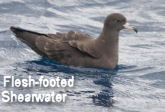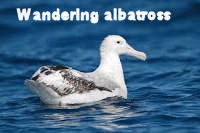disappearance
Birdwatchers highlight declines of seabirds off south-eastern Australia
 Thirteen species of seabirds are declining off the coast of south-eastern Australia, a 17-year study by researchers at the Centre for Ecosystem Science at UNSW Sydney revealed. The species include iconic and globally threatened birds such as the enormous Wandering Albatross, as well as locally breeding Flesh-footed Shearwater. Pelagic citizen science data was used in this study.
Thirteen species of seabirds are declining off the coast of south-eastern Australia, a 17-year study by researchers at the Centre for Ecosystem Science at UNSW Sydney revealed. The species include iconic and globally threatened birds such as the enormous Wandering Albatross, as well as locally breeding Flesh-footed Shearwater. Pelagic citizen science data was used in this study.
Working with data collected by seabird enthusiasts of the Southern Ocean Seabird Study Association, who regularly take boat trips out to sea from Port Stephens, Sydney and Wollongong, the scientists found that almost half of the 30 most commonly observed seabird species in the region had declined over the 17-year period from 2000 to 2016. The study is published in the latest issue of the international scientific journal, Biological Conservation.

“Seabirds are critically important organisms for maintaining the health of marine ecosystems,” says lead author and UNSW Science Honours student Simon Gorta.
“They act as apex predators, feeding on a range of prey such as plankton, squid, fish and carcasses across the world’s oceans.
“Our findings are worrying, not just because thirteen of our more common species are declining, but because we don’t know for sure what is driving these declines.”
While the exact mechanisms are unknown, the researchers suggest that warming ocean temperatures are likely to be contributing to this trend. The East Australian Current has strengthened off south-eastern Australia, which has led to warmer and less productive waters in the region, potentially driving birds to forage elsewhere, as the marine habitat in this region is no longer suitable for them.

“We can predict that as surface temperatures increase with climate change, we will be seeing fewer species that prefer cooler-than-average surface temperatures. The most dramatic example of this was in summer species – Pomarine and Arctic Jaegers - which showed this surface temperature preference and consistently declined in the region over the 17-year study period,” Mr Gorta says.
Worryingly, many other species may also be declining. This is supported by declines in breeding populations of seabirds, linked to a number of threats globally. The researchers say that determining the exact causes of these declines should be a priority.
“Seabirds are the most threatened group of birds on the planet, with roughly 30% of them listed on the IUCN Red List as at risk of extinction,” says co-author Professor Richard Kingsford, Director of the Centre for Ecosystem Science.
“They are threatened where they forage at sea, and where they breed, from commercial fishing and pollution at sea, as well as habitat degradation and introduced predators such as rats at breeding sites.”
Relatively little is known about seabirds away from their breeding grounds, as most research efforts are focused on protecting the species at these sites. The researchers identified a clever solution to this by analysing a citizen science dataset, collected by passionate birdwatchers who go on birdwatching trips or “pelagics” out to sea, looking for seabirds almost every month of the year.
“These types of at-sea observations of seabirds are difficult to come by, so we relied on a unique dataset, collated from birdwatchers’ observations. These datasets are just sitting around from all over the world – waiting to be fully dusted off and used to investigate broader patterns which go well beyond usual three-year funding cycles,” says senior author Corey Callaghan, PhD student at UNSW.
These pelagic seabirds occur in coastal and shelf waters off the coast of every continent except Antarctica, and observations from these trips offer a different, and important insight into the behaviour of seabirds, only otherwise attainable by using expensive tracking equipment on a few individuals.
“These observations inform real and informative trends of great importance to marine ecosystem management and conservation, and they do so through the engagement of the general public. It is important that everyone, not just the researchers, know what is going on in our oceans, because we depend on them, yet they are degrading before our eyes,” says Mr Gorta.
“These issues must be addressed in order to halt the long-term declines of seabirds.”
Where is Billy??!! Thai human rights activist disappearance alert
 Can you *please* read this short article and sign an online petition to help find a Thai Karen human rights activist who has "disappeared" recently, just before he was to give eyewitness testimony in a trial related to the abuses of power alledgedly committed by park officials, including the murder of another activist in September 2011.
Can you *please* read this short article and sign an online petition to help find a Thai Karen human rights activist who has "disappeared" recently, just before he was to give eyewitness testimony in a trial related to the abuses of power alledgedly committed by park officials, including the murder of another activist in September 2011.
There have been frequent human rights abuses against indigenous peoples in Thailand, including forced relocation, denial of basic human rights, burning of villages and rice barns, extrajudicial killings of local leaders and expropriation of lands and assets during the last half century or so, and particularly since the early 1960s when Thailand initiated its national park system. Since 1993, these abuses have been repeatedly confirmed and reported by human rights activists.
At the beginning of 2011, more than 20 families who had been documented residents for over 60 years in Bangkloy Bon Village, inside Kaengkrachan National Park (established on 12 June 1981 and about 200 km southwest of Bangkok), saw their houses being burned and destroyed by park officials.
On the 10th of September, 2011, unidentified gunmen shot and killed Tatkamol Ob-om, a Thai activist who had assisted Porlajee Rakchongcharoen (known as “Billy”) and other Karen villagers in reporting on alleged abuses, violence, illegal logging and elephant poaching committed by park officials. In January 2012, the Phetchaburi Provincial Court brought a case against Chaiwat Limlikit-aksorn, head of the Kaengkrachan National Park Office, charging him with masterminding Mr. Tatkamol’s murder.
Mr. Chaiwat has not been suspended from duty as required under disciplinary regulations regarding officials under criminal investigation. Chaiwat's continued presence at the national park has been a cause of fear among local activists and villagers, particularly those involved in lawsuits against him.
On the 17 April 2014, Billy Porlajee, an indigenous Karen leader and prominent human rights activist, was detained by park officials in Kaengkrachan National Park. Park officials claim that Mr Porlajee was released that same day, yet his whereabouts are unknown. Mr Porlajee was scheduled to give eyewitness testimony on 30 April (2014) in a trial related to abuses of power allegedly committed by park officials, but to date he is still missing.
The detention of Porlajee Rakchongcharoen, his alleged release and subsequent disappearance have raised serious fears for his safety. Please will you take a moment to click the link below and sign the online petition. By signing this petition you are assisting in our efforts to find Mr Porlajee, fighting to ensure justice in current lawsuits and supporting Karen communities in their struggle for a dignified life.
Here is the link. Unfortunately, it seems that the link may not work from everywhere in the world. If you experience trouble connecting to this page, will you please leave a comment below stating your location and a giving short message of support for this petition. Thank you.
Petition on disappearance of Billy Porlajee
(http://www.change.org/en-AU/petitions/ms-yingluck-shinawatra-prime-minister-of-thailand-we-demand-a-prompt-and-thorough-investigation-into-the-disappearance-of-the-indigenous-karen-leader-and-hr-activist-porlajee-billy-and-the-removal-of-chaiwat-as-kaengkrachan-national-park-chief)
Please note that the situation is now further confused by the removal from power of the Thai Prime Minister Yingluck Shinawatra by the Thai Constitutional Court *yesterday*, 7 May 2014. Inside Thailand, this case is now likely to be drowned out by the cacophony of ongoing political chaos that continues to rule in that country. It is therefore crucial that the Thai bureaucracy and national park officialdom are not allowed to hide this serious criminality behind the smokescreen of political confusion and get a strong sense of being under the scrutiny of international public opinion. Please help to reach at least the current goal of 10,000 signatures by next week by re-posting this article far and wide, wherever appropriate. Thank you!
Related youtube clip:
Youtube video clip for petition
Related articles:
Senior park official faces probe
Thailand: Prominent activist feared disappeared
Further resources:
Please see the translator’s introduction (Land Use and Sustainability in the Highlands of Northern Thailand) to Buhpau’s The Karen System of Forest Field Rotation, available in the “Karen Rotational Farming” folder at
https://onedrive.live.com/?cid=0a586522c3d55a14
Please also see one view of the struggle for rights of the Karen people of northern Thailand documented in novel form in Francis Ferguson’s Look Down, see the women weep, available in paper and ebook from Lulu.com. Please search for “Francis Ferguson” from the Lulu.com page or just click this link.
If you have questions about this case or about Thai Karen rights in general, or comments on the petition and so on, please leave a comment below and we will try to answer your questions and comments as soon as possible. This page will be updated if there is any news to be reported. Thank you.


Recent comments